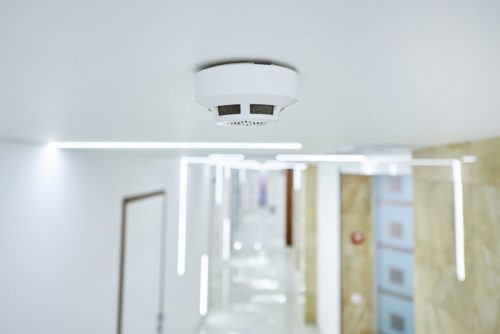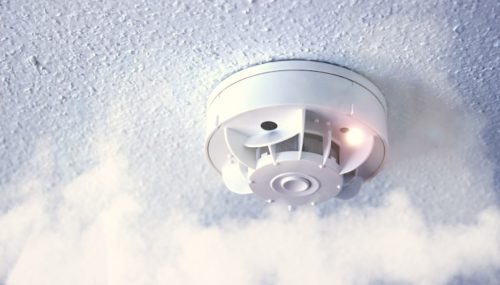Automatic fire detection systems play a critical role in modern fire safety, offering essential protection for both commercial and residential properties.
Designed to provide early warnings, these systems can detect threats such as smoke, heat, or dangerous gases before they escalate. This gives occupants more time to evacuate and allows emergency services to respond swiftly.
Beyond their protective capabilities, automatic fire detection systems are often necessary to meet legal and regulatory standards. This is particularly important in commercial and high-risk environments where fire safety is legally mandated.
BES Security provides tailored fire detection solutions, ensuring that businesses have effective systems in place to safeguard lives and assets.

What is Automatic Fire Detection?
An automatic fire detection system is a network of devices that continuously monitor for signs of fire—such as smoke, heat, or hazardous gases—and automatically trigger an alarm if these signs are detected.
Unlike manual fire alarms that require someone to initiate an alert, automatic systems function independently. They activate alarms as soon as they detect a potential fire threat. This quick response can prevent injury, protect property, and minimise fire damage.
These systems often communicate with other components, such as fire alarms, emergency lighting, or automated ventilation systems, to create a fully integrated safety solution. By swiftly identifying and alerting to fire risks, automatic fire detection systems play a key role in fire safety strategies.
Types of Automatic Fire Detection Systems
Different types of automatic fire detection systems are available, each designed to detect specific fire-related hazards. The main types include:
Optical Smoke Detection
Optical detectors use light sensors to detect smoke particles, making them ideal for identifying slow-burning fires. These are commonly used in living areas, offices, and other environments where smouldering fires are likely.

Ionisation Smoke Detection
Ionisation detectors are especially sensitive to fast-flaming fires, such as those ignited by paper or other rapidly burning materials. They detect smaller smoke particles and are well-suited for areas where rapid ignition fires are possible, like kitchens or workshops.
Heat Detection
Heat detectors respond to temperature changes, making them ideal for environments where smoke might trigger false alarms, such as kitchens. This is particularly useful in spaces where high temperatures are a primary fire indicator.
Carbon Monoxide (CO) Detection
Carbon monoxide detectors identify the presence of CO gas, a dangerous byproduct of incomplete combustion. These detectors are essential in areas where gas appliances are used, as they protect against carbon monoxide poisoning. CO is both odourless and invisible to human senses. It is always recommended to have a CO detector as well as a fire detector.
Each detector serves a unique purpose, and combining multiple methods within a property often provides the most comprehensive fire safety. This approach ensures that various fire risks are addressed, giving occupants and property owners an added layer of protection.
When is an Automatic Fire Detection System Considered Necessary?
Legal Requirements for Automatic Fire Detection
In England and Wales, the Regulatory Reform (Fire Safety) Order 2005 outlines strict requirements for fire detection in certain types of buildings, making automatic fire detection systems essential in various settings.
This legislation mandates that property owners and employers implement adequate fire safety measures, including fire detection, to protect anyone who might be affected by fire on the premises.
Failure to comply with these requirements can result in significant fines, business closures, or even criminal charges in cases of gross negligence.
Automatic fire detection is generally required in multi-occupancy buildings, such as apartment complexes and high-rise residential buildings, to ensure that tenants have sufficient warning in case of a fire.
Similarly, commercial spaces—particularly those open to the public, like retail shops, restaurants, and entertainment venues—must have reliable fire detection systems in place to protect both employees and visitors.
Industrial properties, especially those dealing with hazardous or flammable materials, are also mandated to install automatic fire detection systems to manage heightened fire risks.
These legal requirements aim to establish a baseline level of safety across various property types, ensuring occupants are alerted to fire risks as early as possible.
High-Risk Environments and Industries
Certain environments and industries naturally present higher fire risks, making automatic fire detection systems essential to minimise potential dangers.
Environments that handle flammable materials, such as factories, chemical plants, or storage facilities for combustible products, require automatic detection to swiftly identify any signs of fire.
Early detection in these settings is critical, as even a minor fire can quickly escalate due to the presence of hazardous substances.
Several industries are particularly reliant on automatic fire detection due to their specific operational risks and the number of occupants present.
For example, manufacturing facilities often house a range of machinery and processes that can generate high temperatures, increasing fire risk. Healthcare facilities, such as hospitals and clinics, must protect vulnerable patients who may have limited mobility, making early warning systems critical.
In the hospitality industry, where guests are often unfamiliar with building layouts, immediate alerts are essential for safe evacuations.
Educational facilities also benefit from automatic fire detection, as they often accommodate large numbers of students and staff, requiring prompt alerts to ensure orderly evacuations.
In these high-risk environments, automatic fire detection is not only a recommended safety measure but an essential part of maintaining a secure setting for all occupants.
When Early Detection is Critical
In buildings with vulnerable occupants or where large numbers of people are present, early fire detection is crucial for effective evacuation and safety. Facilities such as hospitals, care homes, and assisted living centres house individuals who may have limited mobility or rely on staff assistance in emergencies, making rapid detection and alerting systems essential.
In these settings, an automatic fire detection system can quickly trigger alarms, initiate evacuation protocols, and alert emergency responders, reducing the risk of harm and giving staff time to assist residents or patients.
Additionally, in larger buildings, such as office towers, hotels, and schools, evacuation can take time due to the scale of the structure and the volume of occupants. Automatic fire alarms in these buildings ensure that all individuals are alerted to danger as soon as possible, minimising evacuation delays.
Rapid alerts also facilitate quicker response times from emergency personnel, who can begin firefighting efforts promptly, thereby containing fire spread and reducing property damage.
In high-risk situations, an automatic fire detection system is not only a preventive measure but a life-saving tool that ensures faster, more organised responses to fire emergencies

Benefits of an Automatic Fire Detection and Alarm System
Early Warning and Rapid Response
One of the most significant benefits of an automatic fire detection and alarm system is its ability to provide instant alerts in the event of a fire. Automatic systems are designed to detect early signs of fire—such as smoke, heat, or harmful gases—and activate an alarm immediately, giving occupants critical time to evacuate safely.
This early warning is especially important in large buildings, where evacuation may take longer, or in properties where occupants may be asleep or otherwise unaware of danger.
Automatic fire alarms also play a crucial role in notifying emergency services promptly. By providing a rapid alert to first responders, these systems reduce the time it takes for firefighters to arrive on the scene, potentially containing the fire before it spreads and minimising overall damage.
Faster response times are critical for saving lives and protecting property, making automatic fire detection systems an essential component of any effective fire safety strategy.
Continuous Monitoring and Peace of Mind
Automatic fire detection systems offer round-the-clock monitoring, ensuring that fire hazards are detected even during off-hours or when a building is unoccupied.
This constant vigilance significantly reduces the risk of fires going unnoticed, especially in situations where no one is present to spot the signs of a fire. For businesses, this means that their premises remain protected 24/7, regardless of staffing levels or working hours.
For property owners, this continuous monitoring provides invaluable peace of mind, knowing that they have a reliable system in place to alert them to any fire risks.
Whether it’s a commercial property, industrial facility, or private residence, automatic fire detection systems offer reassurance that fire hazards will be detected and addressed promptly, safeguarding both lives and assets.
Compliance with Safety Regulations
Installing an automatic fire detection system is also essential for ensuring compliance with fire safety regulations, which vary depending on the type and usage of a building.
Compliance with regulations, such as the Regulatory Reform (Fire Safety) Order 2005 in England and Wales, requires that certain buildings have reliable fire detection and alarm systems to protect occupants and prevent the spread of fire.
Failure to meet these standards can lead to hefty fines, business closures, or even legal consequences in cases of gross non-compliance.
Beyond avoiding penalties, regulatory compliance helps business owners reduce liability, as it demonstrates that they have taken appropriate measures to protect their premises and those within it.
For employers and property managers, adhering to these standards promotes a safer environment for employees, customers, and visitors alike.
By installing an automatic fire detection system, businesses not only meet legal requirements but also demonstrate a commitment to safety, building trust with both staff and clients.
Types of Automatic Fire Detection Systems to Consider
Conventional vs. Addressable Systems
Conventional and addressable fire detection systems are two main types of automatic fire detection systems, each with unique benefits depending on the building type and risk level.
A conventional fire detection system divides the property into zones, with each zone connected to a set of detectors and alarms. When a detector is triggered, the system alerts users to the zone where the fire is located.
Conventional systems are well-suited to smaller properties with simpler layouts, as they offer effective fire detection at a lower cost. However, they may lack the precision needed for large or high-risk buildings, as they cannot identify the specific device that triggered the alarm within a zone.
An addressable fire detection system offers more advanced functionality by assigning an address to each individual device in the network. This enables the system to pinpoint the exact location of the triggered alarm, providing faster and more precise detection.
Addressable systems are ideal for larger buildings or high-risk environments, where immediate identification of a fire’s location is crucial. While more costly, their speed, accuracy, and ability to reduce false alarms make them a valuable investment for complex properties.
Additional Fire Safety Features
To enhance the effectiveness of an automatic fire detection system, integrating additional fire safety features can provide comprehensive coverage.
Emergency Lighting is crucial for illuminating evacuation routes during a fire, helping occupants exit the building safely and quickly. This feature is especially important in large buildings or those with complex layouts.
Automatic Opening Vent (AOV) Systems are another valuable addition, particularly in multi-story buildings or high-occupancy environments. AOV systems automatically open vents or windows when a fire is detected, allowing smoke and hot gases to escape, reducing smoke inhalation risks, and making it easier for emergency responders to manage the fire.
These features work in concert with detection systems, creating an integrated fire safety solution that addresses multiple aspects of fire risk management, ensuring that both occupants and property are protected.
Automatic Fire Detection System FAQs
What is an automatic fire detection system?
An automatic fire detection system is a network of devices designed to identify signs of fire.
These systems alert building occupants and emergency responders, providing crucial early warnings that allow for timely evacuation and response.
How does an automatic fire detection and alarm system work?
Automatic fire detection systems rely on sensors to continuously monitor the environment. When the system detects a fire indicator—such as rising heat, smoke, or dangerous gas levels—it activates an alarm.
This immediate response alerts occupants and can also notify emergency services, expediting evacuation and fire management.
When is an automatic fire detection system legally required?
Automatic fire detection systems are generally required by law in multi-occupancy buildings, commercial spaces, and industrial properties.
Legislation like the Regulatory Reform (Fire Safety) Order 2005 in England and Wales mandates fire detection for certain properties to protect occupants and reduce fire hazards.
What types of detectors are best for an automatic fire alarm system?
The choice of detectors depends on the environment and specific fire risks. Optical detectors are suitable for smouldering fires. Ionisation detectors are effective for fast-flaming fires. Heat detectors work well in areas prone to false alarms from smoke. Carbon monoxide detectors are essential in locations with gas appliances. A combination of these detectors typically provides optimal coverage.
Can an automatic fire detection system be integrated with other safety features?
Yes, automatic fire detection systems can be integrated with emergency lighting, AOV systems, and even security alarms. This integration creates a coordinated response to fire emergencies. This aids in evacuation, minimising smoke inhalation, and providing added security during an incident.
What maintenance is required for an automatic fire detection system?
Regular maintenance is crucial to ensure an automatic fire detection system functions correctly and meets safety regulations. Maintenance includes inspecting and testing detectors, updating software, and checking alarm functionality.
Consistent maintenance helps identify potential issues early, ensuring reliable protection and regulatory compliance.


